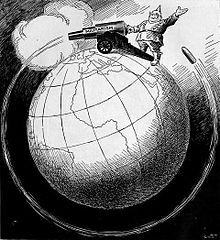
Back معاداة النزعة العسكرية Arabic Antimilitarismu AST Antimilitarisme Catalan Antimilitarismus Czech Gwrthfilitariaeth Welsh Antimilitarisme Danish Antimilitarismus German Kontraŭmilitarismo Esperanto Antimilitarismo Spanish Antimilitarismo Basque

Antimilitarism (also spelt anti-militarism) is a doctrine that opposes war, relying heavily on a critical theory of imperialism and was an explicit goal of the First and Second International. Whereas pacifism is the doctrine that disputes (especially between countries) should be settled without recourse to violence, Paul B. Miller defines anti-militarism as "ideology and activities...aimed at reducing the civil power of the military and ultimately, preventing international war".[1] Cynthia Cockburn defines an anti-militarist movement as one opposed to "military rule, high military expenditure or the imposition of foreign bases in their country".[2] Martin Ceadel points out that anti-militarism is sometimes equated with pacificism—general opposition to war or violence, except in cases where force is deemed necessary to advance the cause of peace.[3]
- ^ From Revolutionaries to Citizens : Antimilitarism in France, 1870–1914 by Paul B. Miller. Duke University Press, 2002, ISBN 0-8223-2757-0, p. 8.
- ^ Cynthia Cockburn, Antimilitarism: Political and Gender Dynamics of Peace Movements. London, Palgrave Macmillan. 2012. ISBN 0230359752, p. 2.
- ^ Martin Ceadel, 'Thinking about peace and war. Oxford, Oxford University Press, 1987. ISBN 0192192000, p. 101.
© MMXXIII Rich X Search. We shall prevail. All rights reserved. Rich X Search